Side Caesar salads are a popular choice for health-conscious individuals, but understanding their calorie content is crucial for making informed meal choices. While this classic dish can be a delicious and satisfying option, it’s important to be aware of the calorie count to ensure it aligns with your dietary goals. In this article, we will explore the calorie content of side Caesar salads, discuss how to make healthier choices, and provide useful tips for enjoying this nutritious and flavorful meal.
- Side Caesar salads can contain around 400-600 calories per serving, depending on the ingredients and portion size.
- Adding healthier substitutions like low-fat dressings and more vegetables can help reduce the calorie count and increase the nutritional value.
- Chicken Caesar salad can be a good option for weight loss due to its low calorie and high protein content, but portion sizes and dressing choices should be considered.
- Be mindful of commercially available side Caesar salads from popular restaurants, as they may have higher calorie contents, especially with certain toppings and dressings.
- Choosing lighter dressings and toppings can help keep the calorie count in check while still adding flavor and variety to your salad.
By understanding the calorie content of side Caesar salads and making informed choices, you can enjoy this popular dish without compromising your health goals. Let’s dive deeper into the world of side Caesar salad calories and uncover the secrets to a delicious and nutritious meal!
The Calorie Count of Side Caesar Salad
Side Caesar salads can range in calorie count, depending on the ingredients and portion size, making it important to pay attention to what goes into your plate. A typical side Caesar salad can contain around 200-300 calories per serving, but this can increase significantly when additional toppings and dressings are added. For example, croutons, bacon, and cheese can contribute to a higher calorie count. It’s important to be mindful of these extras and consider healthier substitutions to keep your salad lighter and more nutritious.
One way to lower the calorie count is by opting for a lighter dressing option. A typical Caesar dressing can be high in calories and fat, but there are low-fat alternatives available that can help reduce the overall calorie content of your salad. Additionally, adding more vegetables to your salad can make it more filling and nutrient-dense without significantly increasing the calorie count. Fresh and crisp lettuce, cherry tomatoes, cucumber slices, and thinly sliced red onions are all great options to add more flavor and nutrition to your plate.
When enjoying a side Caesar salad, it’s important to be mindful of portion sizes. While the salad itself may be relatively low in calories, consuming large portions can quickly increase your calorie intake. Pay attention to the recommended serving size and try to stick to it. Using a smaller plate can also help create the illusion of a larger portion, making it more satisfying. By being aware of the calorie count, making healthier choices with dressings and toppings, and practicing portion control, you can enjoy a delicious Caesar salad while staying health-conscious.
| Toppings | Calories | Portion Size |
|---|---|---|
| Croutons | 50 | 1 serving |
| Bacon | 40 | 2 slices |
| Cheese | 100 | 1/4 cup |
Remember, the calorie count of a side Caesar salad can vary depending on the specific ingredients and portion size. By being mindful of what you add to your plate and making healthier choices, you can enjoy a delicious and nutritious salad without compromising your health goals.
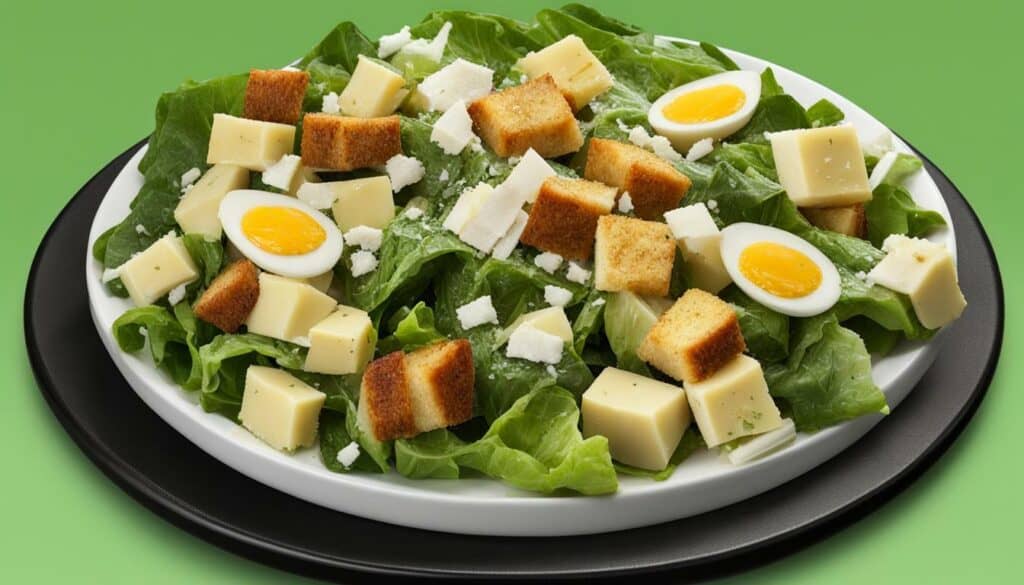
Enjoying a healthy Caesar salad is possible by making smart choices like using low-fat dressings, loading up on vegetables, and opting for lighter toppings. By being mindful of what we add to our salad, we can keep the calorie count low while still enjoying the delicious flavors.
When it comes to dressings, it’s important to choose options that are low in fat and sodium. Look for dressings labeled as “light” or “reduced-fat,” as these will typically have fewer calories and less saturated fat. Another option is to make your own dressing using Greek yogurt or a vinegar-based dressing. These alternatives provide a creamy texture and tangy flavor without the high calorie content.
Incorporating plenty of vegetables into your Caesar salad is a great way to add volume and nutrition without adding too many calories. Load up on crisp romaine lettuce, cherry tomatoes, cucumber slices, and thinly sliced red onions. These colorful additions not only enhance the taste but also provide essential vitamins, minerals, and fiber.
When it comes to toppings, it’s important to choose wisely. Opt for lighter options like grilled chicken breast, shrimp, or tofu instead of high-calorie additions like bacon or fried chicken. If you’re craving some crunch, try adding a sprinkle of toasted almonds or pumpkin seeds. These provide a satisfying texture without the excess calories.
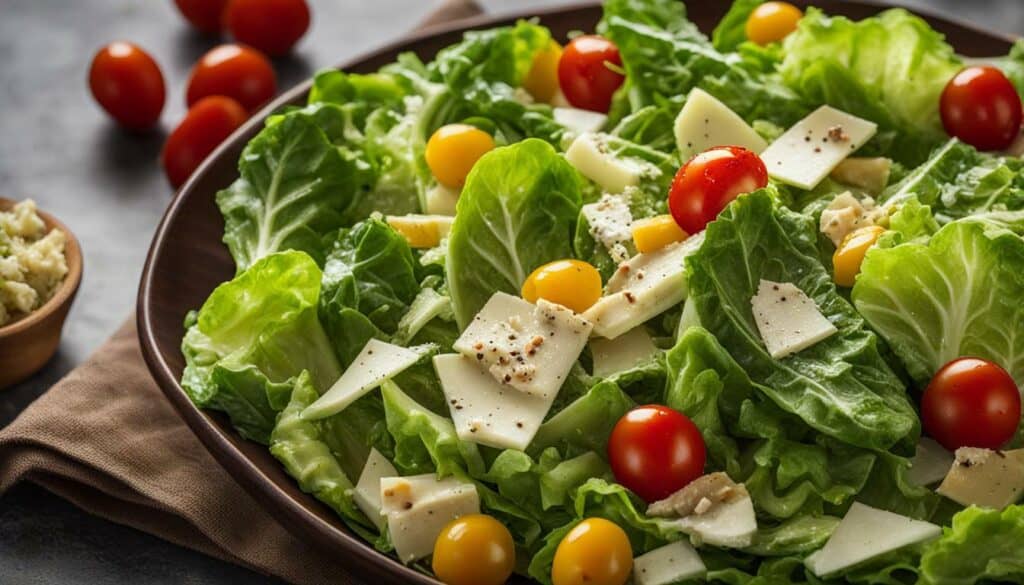
| Toppings | Calorie Count (per serving) |
|---|---|
| Grilled chicken breast (4 oz) | 140 |
| Shrimp (4 oz) | 85 |
| Lightly toasted almonds (1 tbsp) | 35 |
| Thinly sliced red onions (1/4 cup) | 10 |
| Cucumber slices (1/4 cup) | 5 |
By making healthier choices with our Caesar salad, we can satisfy our cravings while still maintaining a balanced and nutritious diet. With low-fat dressings, an abundance of vegetables, and lighter toppings, we can enjoy this classic dish guilt-free.
The Protein Power of Chicken Caesar Salad
Chicken Caesar salad can be a nutritious choice for those looking to lose weight, providing a good amount of protein while being mindful of portion sizes and dressing choices. A typical serving of chicken Caesar salad contains around 400-600 calories, making it a relatively low-calorie option for a satisfying meal. Pairing lean chicken breast with crisp romaine lettuce and a flavorful dressing creates a protein-packed dish that can keep you feeling full and satisfied.
When it comes to portion sizes, it’s important to be mindful. While chicken Caesar salad can be a healthy choice, overeating can easily lead to consuming more calories than intended. Remember to keep your portion sizes in check and enjoy the salad as part of a balanced diet. Additionally, choosing a dressing that is low in saturated fat and sodium can help keep the overall calorie count in check. Opt for a lighter dressing option, such as a vinaigrette or a homemade Caesar dressing made with Greek yogurt, to add flavor without adding excessive calories.
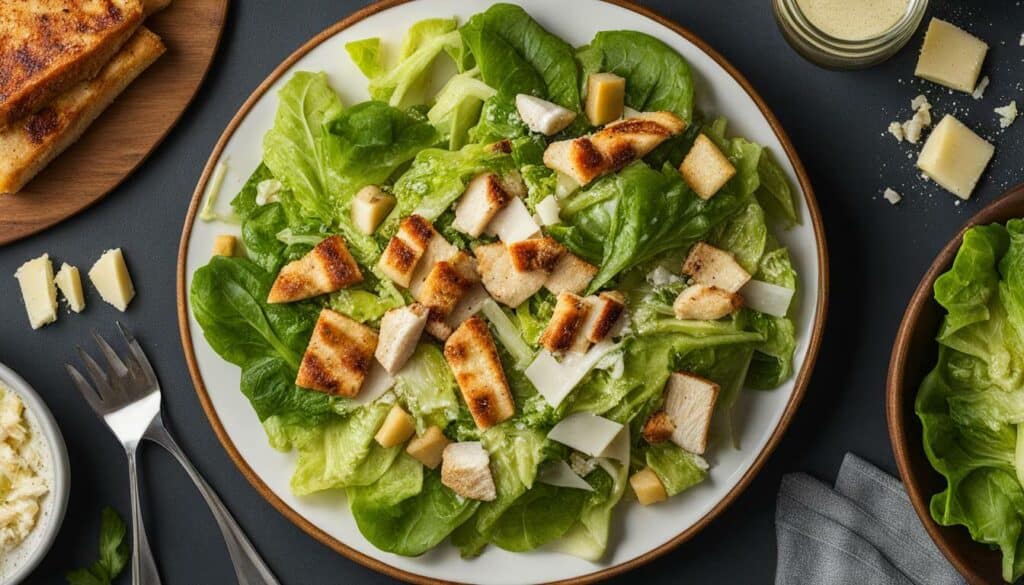
Table: Nutritional Information of Chicken Caesar Salad
| Ingredient | Calories (per serving) | Protein (per serving) | Fat (per serving) | Carbohydrates (per serving) |
|---|---|---|---|---|
| Romaine Lettuce | 10 | 1g | 0g | 2g |
| Grilled Chicken Breast | 150 | 25g | 3g | 0g |
| Caesar Dressing (2 tbsp) | 150 | 2g | 15g | 2g |
| Parmesan Cheese (1 tbsp) | 20 | 2g | 1.5g | 0g |
| Croutons (5 pieces) | 50 | 1g | 2g | 8g |
By including a variety of ingredients in your chicken Caesar salad, you can add flavor and texture while still keeping the calorie count reasonable. Feel free to experiment with additional toppings, such as cherry tomatoes, cucumbers, or even a sprinkle of roasted almonds for an extra crunch. Remember, making healthier choices doesn’t mean sacrificing taste or enjoyment. With smart ingredient choices and mindful portion sizes, you can savor a delicious chicken Caesar salad while staying on track with your health goals.
Commercially Available Side Caesar Salads
When ordering a side Caesar salad from fast-food or casual dining establishments, be aware that certain toppings and dressings can significantly increase the calorie content. While a basic Caesar salad can be a healthy choice, the addition of ingredients like croutons, bacon, and cheese can quickly pack on the calories. It’s important to make informed choices and opt for lighter options whenever possible.
Let’s take a closer look at some popular restaurants and their side Caesar salad offerings:
| Restaurant | Calories | Additional Toppings | Dressing |
|---|---|---|---|
| Wendy’s | 320 | Croutons, Parmesan cheese | Caesar dressing |
| Olive Garden | 350 | Croutons, Parmesan cheese | Caesar dressing |
| Subway | 260 | Croutons, Parmesan cheese | Caesar dressing |
| Panera Bread | 230 | Croutons | Greek dressing |
As you can see, the calorie content of side Caesar salads can vary depending on the restaurant. It’s important to pay attention to the additional toppings and dressing choices. Skipping croutons, opting for less cheese, or choosing a lighter dressing can help keep the calorie count in check. Remember, small changes can make a big difference in maintaining a health-conscious approach to your meals.

In the next section, we will explore optimal dressings for a healthier Caesar salad and how they can contribute to reducing the overall calorie content of your meal.
Optimal Dressings for a Healthier Caesar Salad
Selecting a Caesar salad dressing that is low in saturated fat and sodium can help you enjoy a delicious yet healthier version of this classic salad. By making mindful choices when it comes to dressings, you can reduce the calorie count without compromising on flavor. Here are some options to consider:
- Light or Reduced-Fat Dressings: Look for dressings specifically labeled as “light” or “reduced-fat.” These options typically have fewer calories and less fat than regular dressings.
- Vinaigrette Dressings: Opt for vinaigrette dressings made with olive oil or other heart-healthy oils. They tend to be lower in saturated fat and offer a tangy, flavorful alternative to creamy dressings.
- Yogurt-Based Dressings: Try yogurt-based dressings, such as Greek yogurt Caesar dressings. They provide a creamy texture with less fat and more protein than traditional dressings.
- Homemade Dressings: Consider making your own dressing at home using fresh ingredients. This way, you can control the amount of oil, salt, and other additives, allowing for a healthier and personalized dressing.
Remember to read the labels and pay attention to the serving size when choosing a dressing. It’s also a good idea to experiment with different dressings to find the one that suits your taste preferences. Whether you prefer a lighter vinaigrette or a creamy yogurt-based dressing, there are plenty of options available to create a low-calorie Caesar salad without sacrificing flavor.
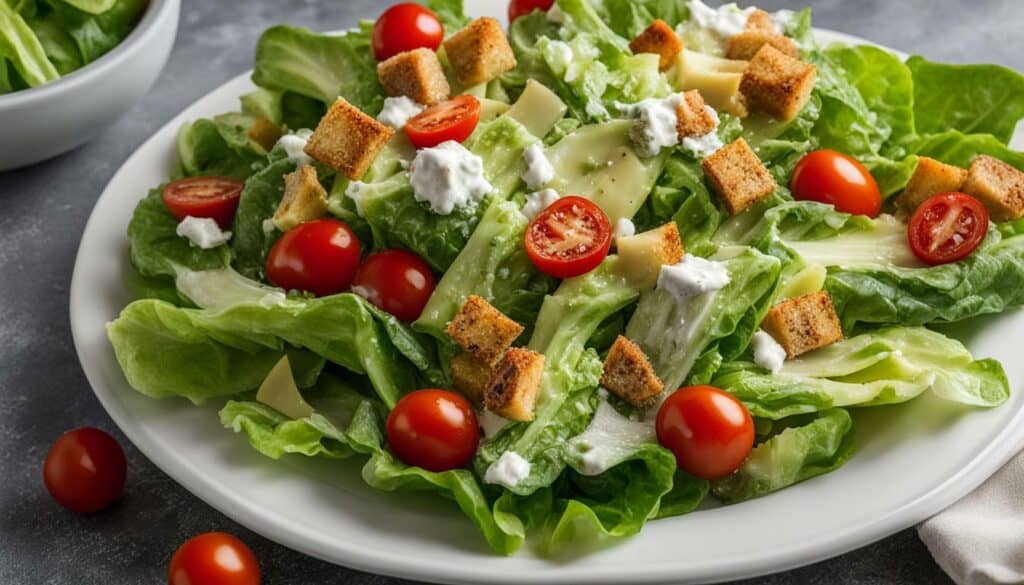
If you’re looking to make your own low-calorie dressing, here’s a simple recipe to try:
| Ingredients: | Amounts: |
|---|---|
| Plain Greek yogurt | 1/2 cup |
| Lemon juice | 1 tablespoon |
| Dijon mustard | 1 teaspoon |
| Garlic (minced) | 1 clove |
| Worcestershire sauce | 1 teaspoon |
| Grated Parmesan cheese | 1 tablespoon |
| Salt | To taste |
| Black pepper | To taste |
Simply mix all the ingredients together in a bowl until well combined. Adjust the seasonings to your liking, and drizzle the dressing over your Caesar salad for a healthier, homemade option that’s both tasty and nutritious.
Adding Flavorful Toppings to Your Caesar Salad
Enhance the flavor of your Caesar salad with a variety of toppings that add a burst of taste without packing on excessive calories. By choosing the right toppings, you can create a delicious and nutritious side salad that satisfies your cravings. Here are some healthy side salad options to consider:
1. Grilled Chicken:
Add a protein boost to your Caesar salad by topping it with grilled chicken. Not only does it add a savory taste, but it also helps keep you feeling full and satisfied. Opt for skinless chicken breast to keep the calorie count in check.
2. Crunchy Vegetables:
Add a crunchy element to your salad with a variety of colorful vegetables. Sliced bell peppers, cherry tomatoes, cucumber, and shredded carrots are all great options. These vegetables not only provide texture but also add essential vitamins and minerals to your meal.
3. Nutty Delight:
Give your Caesar salad a delicious twist by sprinkling it with some chopped nuts. Walnuts, almonds, or pine nuts add a crunchy texture and provide a dose of healthy fats. They are also a great source of protein and fiber, making your salad even more satisfying.
Remember to be mindful of portion sizes when adding toppings to your salad. While these options add flavor and nutritional value, it’s important to maintain balance and not go overboard. Enjoy your Caesar salad with these healthy side salad options and savor every bite!
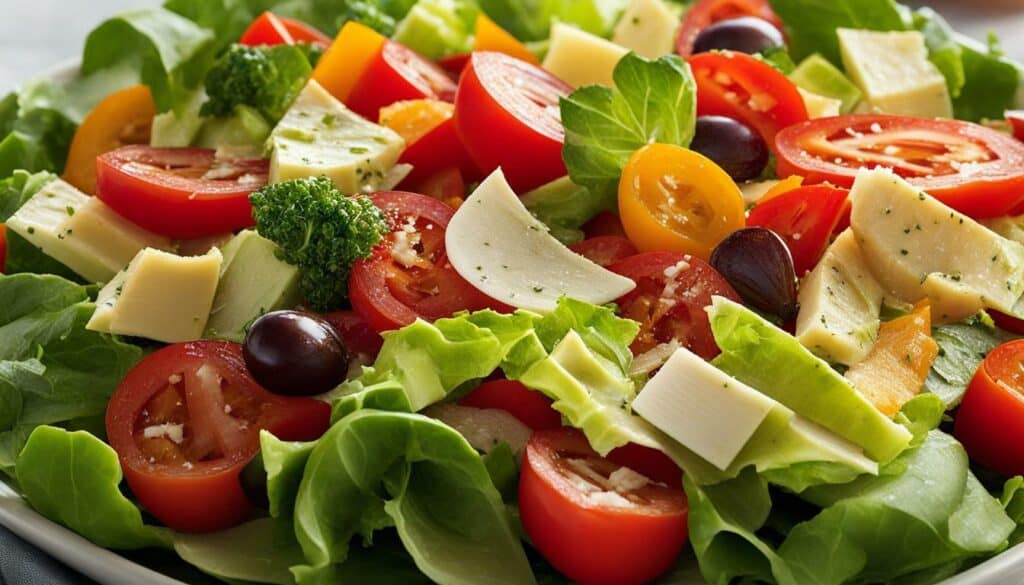
By incorporating a colorful array of vegetables into your Caesar salad, you can boost its nutritional value with essential vitamins, minerals, and fiber. Vegetables are a key component of a healthy diet and can provide numerous health benefits. They are low in calories and high in nutrients, making them an excellent choice for those looking to maintain or improve their health.
When preparing your Caesar salad, consider adding a variety of vegetables such as crisp romaine lettuce, cherry tomatoes, crunchy cucumbers, and vibrant bell peppers. These vegetables not only add texture and flavor to your salad but also provide essential nutrients like vitamin C, vitamin A, and dietary fiber. Vitamin C is important for immune function, while vitamin A supports healthy vision and skin. Dietary fiber aids in digestion and can help you feel fuller for longer, promoting healthy weight management.
One way to make your Caesar salad more visually appealing and nutrient-dense is by incorporating different colored vegetables. The vibrant hues of the vegetables indicate the presence of various antioxidants that can help protect against damage from free radicals and reduce the risk of chronic diseases. For example, red bell peppers contain the antioxidant lycopene, which has been linked to a lower risk of certain cancers and cardiovascular diseases.

| Vegetable | Nutrients |
|---|---|
| Romaine lettuce | Vitamin A, vitamin K, folate |
| Cherry tomatoes | Vitamin C, lycopene |
| Cucumbers | Vitamin K, potassium |
| Bell peppers | Vitamin C, vitamin A, lycopene |
Remember to wash and chop your vegetables thoroughly before adding them to your Caesar salad. This will help remove any dirt or pesticides that may be present on the surface. Additionally, consider using organic produce whenever possible to minimize exposure to synthetic chemicals. With a colorful array of vegetables, your Caesar salad can be both visually appealing and packed with essential nutrients.
Portion Sizes Matter
While side Caesar salads can be a healthy choice, it’s crucial to watch your portion sizes to avoid consuming excessive calories. A typical serving of a side Caesar salad contains around 200-300 calories. However, if you’re not careful with your portions, you could easily double or triple that calorie count.
When enjoying a side Caesar salad, it’s important to remember that the calorie content is not only determined by the ingredients but also by the amount you consume. To help you make smarter choices, here are some tips for portion control:
- Use a smaller plate or bowl to create the illusion of a larger portion.
- Measure your dressing and toppings instead of pouring them liberally.
- Focus on having a balanced meal with other low-calorie options.
- Be mindful of mindless eating and avoid distractions while dining.
By being mindful of your portion sizes, you can enjoy a side Caesar salad without sabotaging your healthy eating goals. Remember, it’s not just about what you eat, but also how much you eat.
| Toppings | Calories |
|---|---|
| Croutons (1 cup) | 120 |
| Bacon (2 slices) | 80 |
| Parmesan Cheese (2 tbsp) | 60 |
As you can see, even seemingly small additions like croutons, bacon, or cheese can significantly increase the calorie count of your side Caesar salad. It’s important to be mindful of these toppings and use them in moderation if you’re watching your calorie intake.
A Word on Smart Ingredients
Selecting high-quality ingredients, such as fresh and organic produce, can elevate the nutritional value of your Caesar salad. By opting for these smart ingredients, you not only enhance the taste but also make your salad healthier and more enjoyable. Fresh vegetables, such as crisp romaine lettuce, juicy cherry tomatoes, and crunchy cucumbers, provide essential vitamins, minerals, and fiber that promote overall well-being.
When it comes to the dressing, consider using a lighter option like a low-fat Caesar dressing or a homemade vinaigrette. These alternatives can significantly reduce the calorie content while still adding flavor to your salad. Additionally, choosing lean protein sources, such as grilled chicken or shrimp, can boost the protein content without adding excess calories or unhealthy fats.
To give your Caesar salad a delightful twist, experiment with alternative ingredients and toppings. Consider adding nutrient-packed options like avocado slices, roasted chickpeas, or a sprinkling of toasted nuts for an extra crunch. These additions not only enhance the overall taste but also provide a nutritional boost to your salad.
| Smart Ingredient | Nutritional Benefits |
|---|---|
| Fresh Romaine Lettuce | High in vitamins A and K, as well as folate and fiber. |
| Cherry Tomatoes | Rich in antioxidants, vitamin C, and lycopene. |
| Cucumbers | Hydrating and a good source of vitamin K and potassium. |
| Avocado | Packed with healthy fats, fiber, and vitamins C, E, and K. |
| Roasted Chickpeas | High in protein, fiber, and several essential minerals. |
| Toasted Nuts | Provide healthy fats, protein, and additional crunch. |
By focusing on the quality of your Caesar salad ingredients, you can create a healthier and more satisfying dish. Striking a balance between flavor and nutrition is key, and incorporating smart ingredients will ensure you’re making conscious choices while still enjoying the delectable appeal of a Caesar salad.
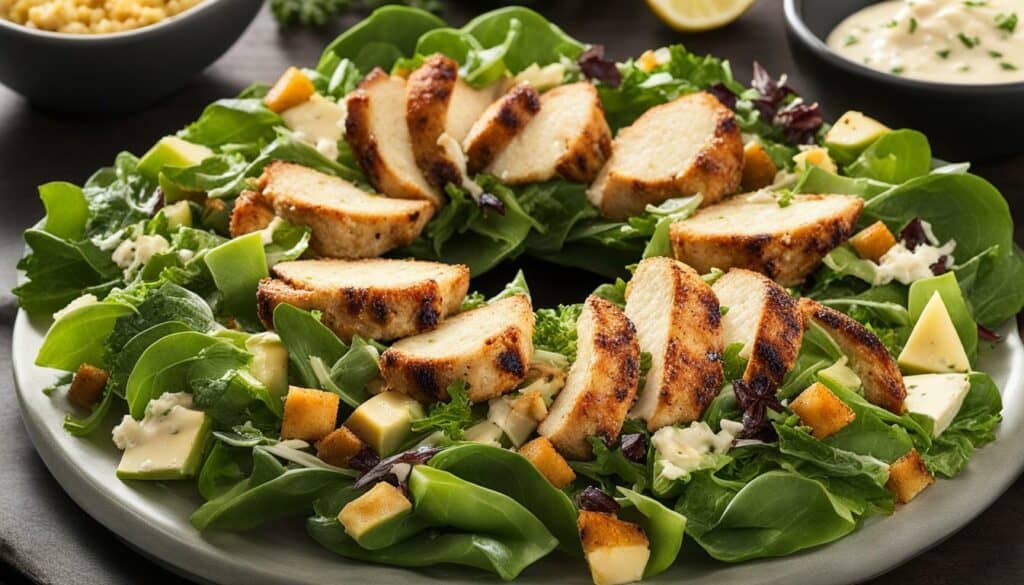
Want to put a healthy twist on your Caesar salad? Explore delightful variations that incorporate alternative ingredients and toppings for a refreshing change. By adding unique flavors and nutritious elements, you can elevate your Caesar salad to a whole new level of deliciousness.
One way to add a twist to your Caesar salad is by incorporating different types of greens. Instead of sticking to the classic romaine lettuce, try using a combination of baby kale, arugula, and spinach. These leafy greens not only provide a variety of textures but also bring additional nutritional benefits such as iron, vitamins, and antioxidants.
In addition to greens, you can experiment with different protein options to make your Caesar salad more satisfying. Grilled shrimp or salmon can add a burst of flavor and omega-3 fatty acids. Alternatively, you can try vegetarian options like roasted chickpeas or marinated tofu for a plant-based twist. These protein alternatives are not only healthier but also provide a different taste experience.
To add some crunch and texture to your Caesar salad, consider swapping traditional croutons with nutritious alternatives. Toasted almonds or walnuts can provide a satisfying crunch while adding heart-healthy fats. You can also include a handful of pomegranate seeds for a burst of sweetness and antioxidants. These variations will not only elevate the taste of your salad but also enhance its nutritional profile.
Delightful Caesar Salad Variations
| Variation | Ingredients |
|---|---|
| Mediterranean Twist | Romaine lettuce, cherry tomatoes, Kalamata olives, feta cheese, red onion, cucumber, oregano, lemon-olive oil dressing |
| Asian Fusion | Napa cabbage, shredded carrots, mandarin oranges, sliced almonds, sesame ginger dressing |
| Taco Salad | Romaine lettuce, black beans, corn, tomatoes, avocado, crushed tortilla chips, cilantro-lime dressing |
These are just a few examples of the many delightful variations you can create with a Caesar salad. Get creative with your ingredients and toppings, and don’t be afraid to try new combinations. The key is to keep your salads colorful, flavorful, and packed with nutritious elements. Enjoy exploring different Caesar salad variations that suit your taste and dietary preferences!

With a conscious approach to side Caesar salad calories and choices, you can enjoy a delicious and nutritious meal without compromising your health goals. A typical serving of chicken Caesar salad can contain around 400-600 calories, depending on the ingredients and portion size. So, it’s important to be mindful of what goes into your salad to keep the calorie count in check.
Making healthier substitutions can make a big difference. Opt for a low-fat dressing instead of the regular creamy one to reduce both calories and saturated fat. Adding more veggies, such as cherry tomatoes, cucumbers, or bell peppers, not only adds flavor and crunch but also boosts the nutritional value of your salad. These additions are low in calories and high in fiber, vitamins, and minerals.
If you’re looking to shed some pounds, chicken Caesar salad can be a good option. With its protein-rich chicken, it keeps you feeling satisfied for longer. Just remember to watch your portion sizes and choose a dressing that is low in saturated fat and sodium. Many commercially available Caesar salads can be higher in calories, especially if you opt for extra toppings like croutons, bacon, or cheese. So, it’s best to be mindful of these additions and opt for lighter alternatives whenever possible.
By being conscious of both the calorie content and the choices you make in your side Caesar salad, you can enjoy a wholesome meal that satisfies your taste buds and supports your health goals. So go ahead and create your own flavorful combinations, experimenting with different dressings, toppings, and vegetables. With a little creativity and mindfulness, you can transform this classic dish into a nutritious and guilt-free delight.
FAQ
Q: How many calories are typically in a chicken Caesar salad?
A: A typical chicken Caesar salad can contain around 400-600 calories per serving.
Q: Can the calorie count of a Caesar salad vary?
A: Yes, the calorie count can vary depending on the ingredients and portion size, as well as any additional toppings like croutons, bacon, or cheese.
Q: How can I make a Caesar salad healthier?
A: You can make a Caesar salad healthier by using a low-fat dressing, adding more vegetables, and choosing lighter toppings.
Q: Is chicken Caesar salad a good option for weight loss?
A: Yes, chicken Caesar salad can be a good option for weight loss due to its low-calorie and high-protein content. However, portion sizes and the choice of dressing need to be considered.
Q: Are commercially available Caesar salads high in calories?
A: Commercially available Caesar salads from places like Wendy’s, Olive Garden, Subway, and Panera Bread can have higher calorie contents, especially when certain toppings and dressings are added.
Q: What dressings should I choose for a healthier Caesar salad?
A: Opt for dressings that are low in saturated fat and sodium to keep the calorie count in check.
Q: What are some flavorful toppings I can add to my Caesar salad?
A: There are many flavorful toppings that can be added to your Caesar salad. Consider options such as roasted vegetables, grilled chicken, or a sprinkle of parmesan cheese.
Q: Why should I add more vegetables to my Caesar salad?
A: Adding more vegetables to your Caesar salad provides additional nutrients, such as vitamins, minerals, and fiber, making it more nutrient-dense.
Q: Do portion sizes matter when enjoying a Caesar salad?
A: Yes, portion sizes do matter. It’s important to practice portion control and mindful eating when enjoying a Caesar salad.
Q: Are there any smart ingredients I should look for in a Caesar salad?
A: Look for quality ingredients, such as fresh and organic produce, to create a healthier Caesar salad.
Q: Can I create unique variations of Caesar salad?
A: Yes, there are many delightful variations of Caesar salad that you can try by using alternative ingredients and toppings to create unique, healthy versions of this classic dish.
Q: How can I stay health-conscious while enjoying a Caesar salad?
A: To stay health-conscious while enjoying a Caesar salad, be aware of the calorie content, make healthier choices with dressings and toppings, and practice portion control.
How Many Carbs Are in Caesar Salad Dressing?
Caesar salad dressing carb breakdown reveals that the classic dressing usually contains around 2 grams of carbs per tablespoon. However, these counts can vary depending on the brand and homemade recipes. Considering portion sizes is crucial when watching carb intake, as excessive dressing can significantly increase carb consumption.

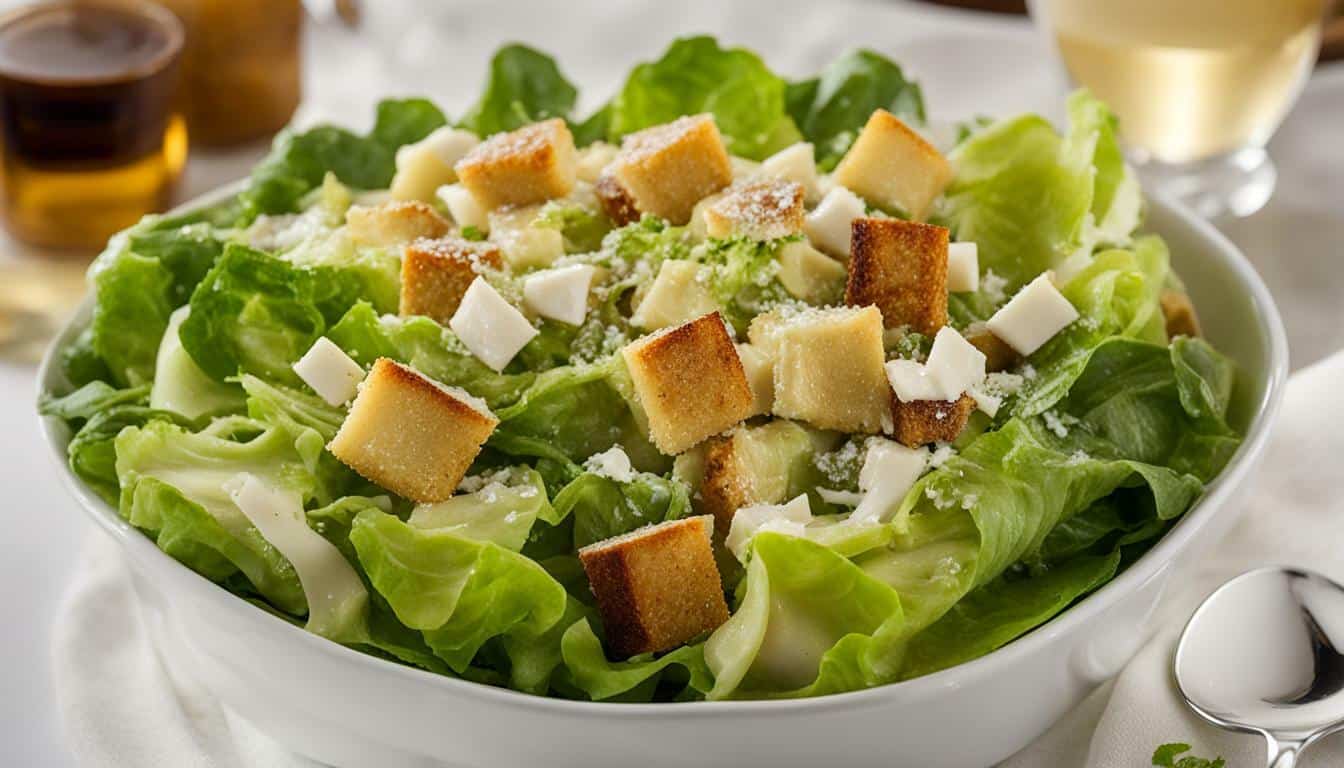



Leave a Reply